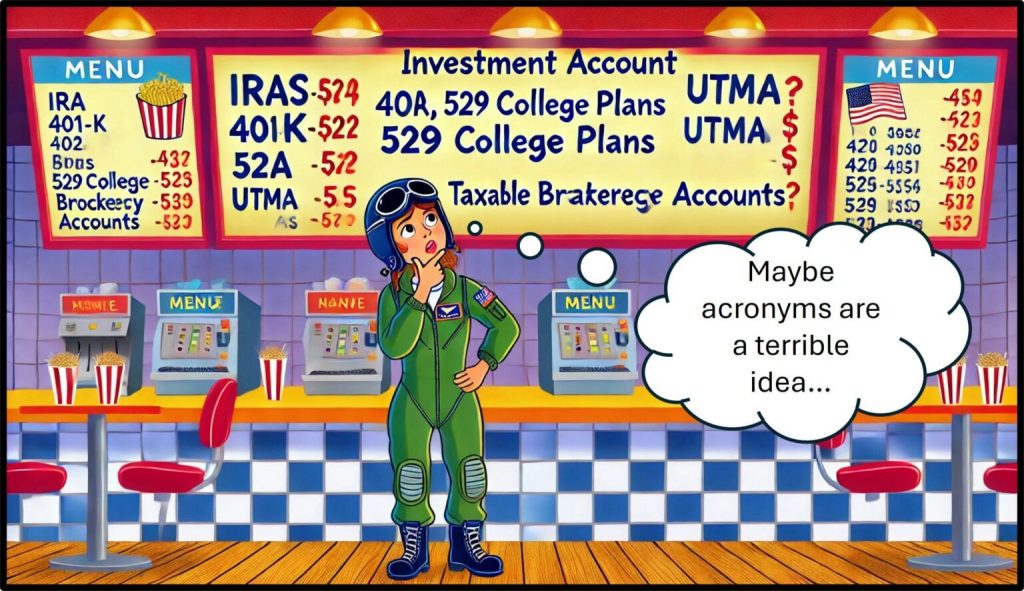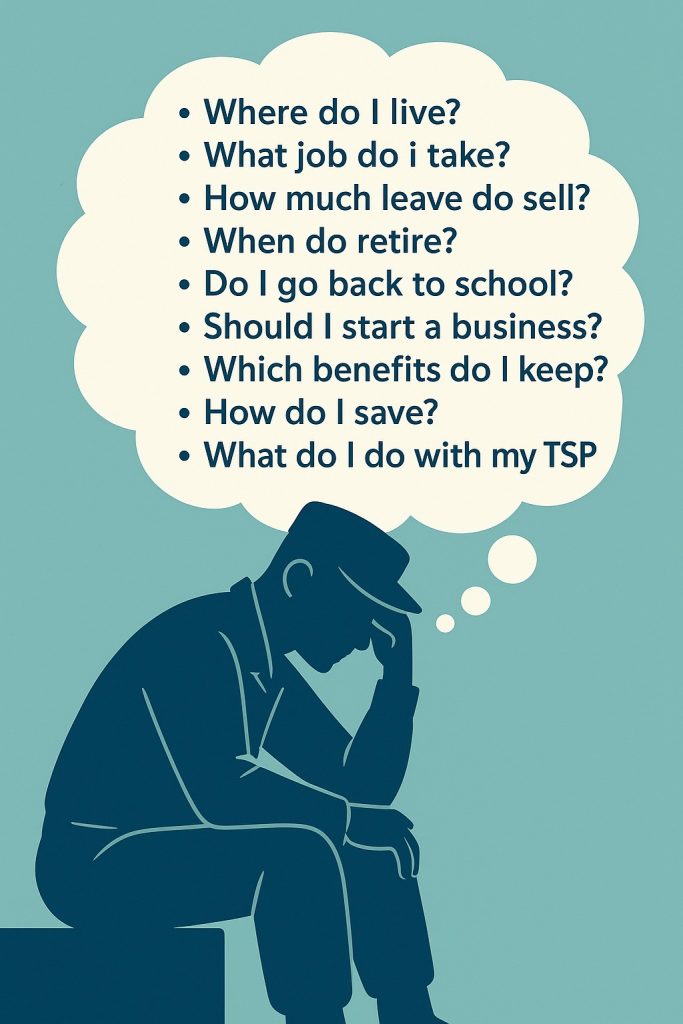Some years ago, when some of our fellow steely-eyed killers started swapping paint at 600 knots a bit too frequently, “back to basics” became the method from on high. The Bobs felt that we had lost touch with some basic airmanship and general knowledge. If we went back to the basics, we could save some blood and treasure. But, what if no one ever taught us the basics, say about something like the important topic of investing accounts? Enter this article!
Account Types 101
There are only a handful of investing or other types of accounts that most of us need to know about. To avoid clutter, I’m not even going to talk about the others. Here we go!
The five accounts you need to know about are: IRAs, Employer Plans, Taxable Brokerage Accounts, 529 College Savings Plans, and UTMA/UGMA accounts. We’ll skip banking accounts like checking, savings, High Yield Savings Accounts, and CDs for now.
IRA: An IRA is an Individual Retirement Arrangement, btu most of us call it an Individual Retirement Account. Let us never speak of this silly distinction again.
- An IRA is a tax-advantaged account you set up yourself (or an advisor helps).
- It has nothing to do with your TSP or 401(k).
- The IRS sets limits on how much you can invest in an IRA each year, $7K under age 50 in 2025.
- IRAs come in 2 basic flavors, and you can inherit someone’s IRA:
- Roth: No deduction on your tax return, but the growth and distributions are generally tax-free.
- Traditional: Deduct the contribution on your tax return, subject to limitations, no taxes while the money grows, but pay taxes when you take distributions in retirement.
- You can have many IRAs, move money from Traditional IRAs to Roth IRAs, move money from Employer Plans to IRAs, move IRAs to Employer Plans, and consolidate IRAs, subject to various rules and potential tax requirements.
Employer Retirement Plans: Employers can offer various plans to help employees save for retirement. We usually call them the TSP, 401(k), 403(b), SEP IRA, SIMPLE IRA, 457(b or f), etc., but they are probably best aggregated under the term “Employer Plan.”
Employer Plans are tax-advantaged accounts only your employer can set up unless you’re self-employed. The rules for employer plans are a mix of what the IRS allows and what the employer chooses to pay to offer. The more complex the plan, the less likely you’ll find it at a small employer because employers pay handsomely to offer these plans.
- Employer plans can also offer Roth or Traditional options based on the same tax treatment as IRAs.
- The IRS sets the contribution limits for employer plans, but they are much higher than IRAs.
- Employers usually match employee contributions to a certain point and can share profits into the plans.
- You can usually keep your employer plan after leaving the job, but you may not want to.
Taxable Brokerage Accounts, or taxable accounts, are just “regular investing accounts” in that you don’t get a tax break when you contribute; you pay tax on some of the earnings each year, and you pay tax on the gains when you sell investments. Taxable accounts are often used for extra retirement savings, savings goals short of retirement, and even for “early retirement.” The “taxable” moniker may sound like a bad deal, but generally, the tax burden is modest and manageable. Usually, the tax rate on a taxable account is lower than the tax rate for other types of income.
- Taxable accounts create flexibility because you don’t have to wait until retirement use the money.
- Taxable accounts generally allow access to the entire universe of publicly traded securities.
- Taxable accounts can be jointly or individually owned.
- Taxable accounts can have beneficiary designations to make estate planning easier.
- Taxable accounts get a “step-up in basis” when you die which usually means that any built-in taxable gains go away.
Families that save a lot usually max out their IRAs and employer plans, so a taxable account is the next logical place to put money to work.
529 College Savings Plans: 529 plans are like a Roth IRA for college. They are only a few decades old and have lots of great upsides, but there is one major downside. 529 plans are the de facto savings option for college expenses, and they can help with K-12 expenses and loan repayment too. Features include:
- No federal tax deduction for contributions, but many states with income taxes allow a state deduction.
- Growth is tax-free.
- Distributions for qualified (most college-related) expenses are tax-free.
- You can change the beneficiary to another family member (even grandkids).
- You can roll over leftover money to a Roth IRA, subject to restrictions.
- The downside is that if you can’t or don’t use the money for a qualified expense, you’ll pay income tax plus 10% on the earnings.
UTMA/UGMA Accounts: Uniform Transfer/Gift to Minors Act accounts are taxable accounts with modest tax advantages that we can set up for our kids. It’s probably best to think of these as wealth transfer and gifting accounts, but some families use them as college savings accounts. Key features include:
- The custodian (usually the parent) operates the account for the child’s benefit until the state age of majority, usually 18-25, then the child takes it over.
- The first few thousand dollars of income are tax-free or at low tax rates, but accounts earning lots of dividends or capital gains can start weighing on the parents’ tax bill.
- The investment options are generally the same as any other taxable account, but these can hold more “exotic” investments.
- Because these must be transferred to the child at a young adult age, many families defer funding until they know what path their child is on to avoid pouring gas on a fire.
Cleared to Rejoin
That’s it. There are really 5 account types you need to care about. Yes, the financial industry gives other names to these basic accounts. Yes, there are many other account types, but the vast majority of us will only ever need to interact with these five and probably not even all five. These are the account type basics, should you ever need to go back to basics.
Need help opening one of these accounts or confused about what you actually invest in? Set up a call with Brian or one of the other MQFPs to talk about your situation.

